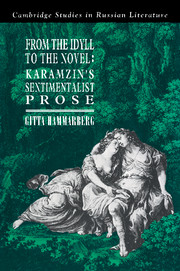Book contents
- Front Matter
- Contents
- Preface and acknowledgments
- Notes on the text
- 1 The literary and intellectual context
- 2 Theory of Sentimentalism
- 3 The literary model: the idyll
- 4 The extra-literary model: salon trifles
- 5 Serious Sentimental tales: narrator as narratee
- 6 Humorous Sentimental tales: narrator as parodist
- Notes
- Bibliography
- Index
2 - Theory of Sentimentalism
Published online by Cambridge University Press: 22 September 2009
- Front Matter
- Contents
- Preface and acknowledgments
- Notes on the text
- 1 The literary and intellectual context
- 2 Theory of Sentimentalism
- 3 The literary model: the idyll
- 4 The extra-literary model: salon trifles
- 5 Serious Sentimental tales: narrator as narratee
- 6 Humorous Sentimental tales: narrator as parodist
- Notes
- Bibliography
- Index
Summary
A BAKHTINIAN THEORY OF NARRATOR
The validity and implications of the claims made for authorial dominance in Sentimentalist fiction depend on how ‘author’ is defined. I shall view ‘author’ as a constitutive element of narrative structure, following a narrative theory developed by M. M. Bakhtin and V. N. Voloshinov, complemented with insights of Jakobson, Doležel, and Titunik, and, to a lesser extent, V. V. Vinogradov and modern speech act theory (henceforth SA theory) as represented by J. L. Austin, John Searle, and H. P. Grice. The major advantage of the Bakhtin–Voloshinov theory is that the pragmatic framework of analysis is wholly appropriate to literature as a sui generis human activity, without reducing it to language, psychology, philosophy, and so on. Linguistic, psychological, and other aspects of a literary work are not thereby denied; they are simply relegated to a lower level of analysis, conditioned by, and subordinate to, properly literary categories.
On the most general level, literature is seen as a specific sphere of human socio-verbal interaction and thus operates within a set of conventions (or norms) peculiar to that sphere. A work of literature is defined as a ‘turn’ in this interaction, an ‘utterance’ in the full pragmatic sense of the term, or as a line or retort (replika) in a dialogical chain of utterances. As a ‘turn’, it is a separate unit, and its borders are clearly defined by the alternation of speakers.
- Type
- Chapter
- Information
- From the Idyll to the NovelKaramzin's Sentimentalist Prose, pp. 15 - 43Publisher: Cambridge University PressPrint publication year: 1991



